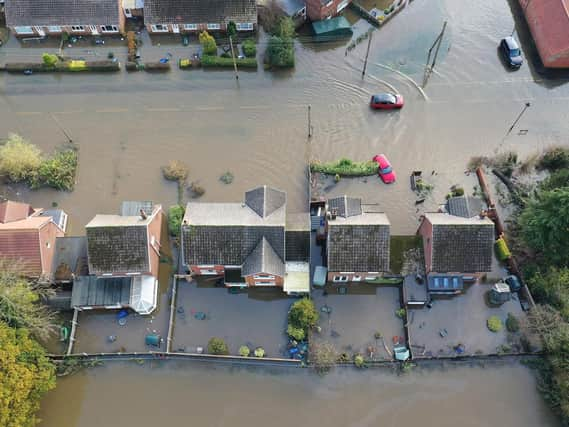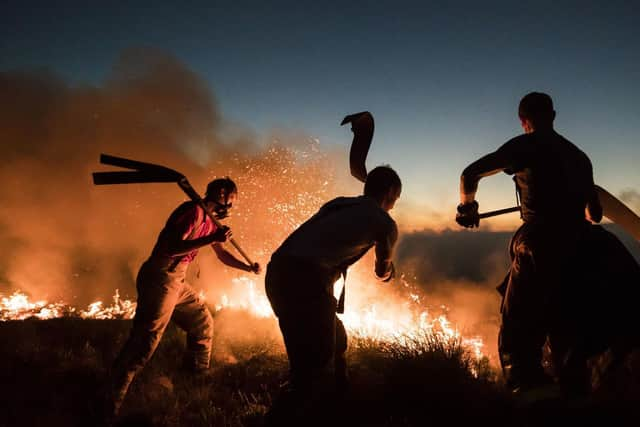How Yorkshire is being affected by climate change - and what we can do about it


In the shadow of Sheffield’s Weston Park Museum is a cluster of instruments surrounded by a wrought-iron gate. Most people do not even seem to notice as they stroll past the manicured lawns but here is one of the oldest weather stations in the country that today remains in continuous operation.
Weston Park weather station was established in 1882. There had been a spate of epidemics of bacterial diseases in the Steel City and officials wanted to investigate whether the weather was somehow responsible.
Advertisement
Hide AdAdvertisement
Hide AdThe weather station was equipped with gleaming new instruments and manned by the then museum curator, Elijah Howarth. Initially Howarth started taking readings four times a day and noting them down in leather-bound ledgers the museum still keeps in its archives.


He soon became something of a local celebrity, nicknamed Elijah the Prophet for his forecasting ability.
The Met Office adopted Weston Park as one of its official weather stations in the 1890s and on July 24 2019 the 50,000th row of data was entered into its ledgers.
Due to its sheer longevity, there are few better places to illustrate exactly how our weather is being profoundly altered as a result of climate change.
Advertisement
Hide AdAdvertisement
Hide AdThe records show that while our weather has always been variable, over the past century or so things have been getting undeniably warmer, with higher spikes of extreme rainfall.
The weather station has recorded more rainfall of 50mm upwards in the past 40 years than there were in the previous hundred.
The year 2019 was Sheffield’s wettest on record and on July 25 that year the city experienced its hottest ever day at 35.1C. During the winter of 2019/20 not a single record of settled snow was logged by the weather station. And yet in the early decades of the station there was a fountain in Weston Park that regularly froze solid every winter.
I live in Sheffield and remember well that sodden winter of 2019 when in November the city was mired in unprecedented rainfall.
Advertisement
Hide AdAdvertisement
Hide AdUnlike the disastrous floods of June 2007, which led to two deaths in Sheffield, this time the defences largely held. The residents of Fishlake, near Doncaster, further downstream along the River Don, were not so fortunate and more than 160 homes and businesses were deluged that same month, leaving dozens homeless.
I spent several days in Fishlake, interviewing those poor souls who had been flooded out of their homes and left camping out in the village pub. People who had lived in the village their entire lives and even seen the odd flood previously spoke of never experiencing anything like it.
As a journalist I have worked for much of my career in Yorkshire. I started at the Halifax Evening Courier in 2007 before joining The Yorkshire Post and then the Daily Telegraph, where I have written its weekly Weather Watch column for the past eight years. I have covered repeated flooding in the Calder Valley and beyond and in 2018 was at Saddleworth Moor at the scene of the worst wildfire in living memory.
In writing my new book, Forecast: A Diary of the Lost Seasons, I wanted to investigate how climate change is altering every day. To examine how our warming climate is rapidly altering the traditional concept of the four seasons that has shaped the British landscape and culture for hundreds of years and upon which all life depends. And how it is sending nature haywire and, at a deeper level, humans into a similar state of flux.
Advertisement
Hide AdAdvertisement
Hide AdMigratory birds such as swallows, heralded in folklore as a harbinger of summer, are these days arriving from their African migration a fortnight earlier than in the 1960s and breeding 11 days earlier.
In recent years, swallows have been spotted as early as February, while there have been reports of the birds even over-wintering in the south of the country. Other species that traditionally come to the British Isles from the tundra over winter are now staying put due to warmer temperatures. The Bewick’s swan, for example, whose arrival on these shores has long been seen as marking the onset of winter, declined by 88 per cent between the winters of 1993/94 and 2018/19 as they preferred not to cross the North Sea. Flowers such as daffodils and bluebells are now coming into bloom two to three weeks earlier than they were 30 years ago.
Last January I joined volunteers from the Botanical Society of Britain and Ireland on a walk around the North Yorkshire village of Staveley on their New Year Plant Hunt. The nationwide event, now a decade old, counts the number of flowering species in the first few days of the year to investigate how warming temperatures are affecting flora. This year volunteers notched up a record 710 different plant species in bloom, compared to 615 in 2020 and 627 in 2019.
You may question whether it matters all that much exactly when a flower comes into bloom or a bird touches down in Britain following a 5,000-mile migration from sub-Saharan Africa. Or that in recent years there have even been reports of frogspawn in November when the mating season traditionally begins in spring. But our flora and fauna have evolved to be finely tuned along so-called “seasonal pulses”, each dependent on the other for survival. And yet my journey in pursuit of the seasons has also given me hope that even as this link between weather and nature appears to be broken, we can help reverse this process.
Advertisement
Hide AdAdvertisement
Hide AdIn summer 2019 I revisited Saddleworth Moor one year on from the wildfire that ravaged 1,000 hectares. Up on Saddleworth, conservationists have installed around 8,000 gulley blocks – anything from hay bales to stone dams – in the moorland streams to help raise the water table and restore the landscape to what it once was before being drained in the latter half of the 20th century.
Plugs of brilliant-green sphagnum moss, capable of holding eight times their own weight in water, have also been planted to improve the resilience of the moor against wildfire, as well as prevent flooding in the valleys below.
Due to the restoration work, the largely treeless landscape is also now slowly beginning to rewild itself, with saplings of willow, aspen and rowan taking root. Increasing the resilience of the land to cope with more extreme weather has in turn created new life.
On the parts of moorland that have been restored, populations of threatened moorland birds, including the dunlin, golden plover and curlew have all significantly increased.
Advertisement
Hide AdAdvertisement
Hide AdRewetting the moorland also restores its purpose as a carbon sink, helping to slow climate change. In the Peak District alone, 20 million tonnes of carbon is stored in the peat. Here, in the wake of wildfire, was evidence of humans helping heal the land. Our connection to the seasons, and in the process a deeply rooted sense of self and place, is slowly returning to life.
Spring 'now eight days early'
The branch of science examining how the weather is shaping the natural world is called phenology.
The Royal Meteorological Society co-ordinated a national recorder network, which ran between 1875 and 1948, noting the emergence of flowers, birds and insects.
Nowadays the Woodland Trust’s Nature’s Calendar project is the largest phenology network in Britain.
Advertisement
Hide AdAdvertisement
Hide AdAccording to figures published in April, its records show spring arriving on average 8.4 days earlier, when you compare the past 20 years to the early 20th century.
Forecast: A Diary of the Lost Seasons by Joe Shute is published by Bloomsbury Wildlife. It is available to buy at Bloomsbury.com and also from your local bookshop.
Support The Yorkshire Post and become a subscriber today. Your subscription will help us to continue to bring quality news to the people of Yorkshire. In return, you'll see fewer ads on site, get free access to our app and receive exclusive members-only offers. Click here to subscribe.
Comment Guidelines
National World encourages reader discussion on our stories. User feedback, insights and back-and-forth exchanges add a rich layer of context to reporting. Please review our Community Guidelines before commenting.